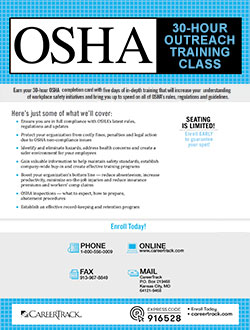Requirements
- A tablet, laptop or desktop computer with keyboard, video camera and microphone capabilities.
- Attendees must participate and be visible to the entire class for all of the 5-day training event.
- Internet connection, broadband wired or wireless (3G or 4G/LTE).
- 2-way audio: speakers and a microphone – built-in or USB plug-in or wireless (note: students can use the microphone and speakers built into a tablet, laptop or desktop computer. Headphones or earphones with a microphone are also recommended, but not required.)
- 2-way video – built in or USB plug-in video web camera (note: students can use the video camera internal to their device or use an external device).
- Smartphones will not be permitted as a device to attend this virtual session.
Are OSHA violation and workplace safety issues costing your organization?
According to the United States Department of Labor, businesses spend $170 billion a year on costs associated with work-related injuries and illnesses. This can contribute to decreased employee morale, reduced productivity, and higher on-the-job stress, while leading to increased workers' comp claims, higher insurance premiums, retraining costs, absenteeism, and lower-quality products and services.
Workers whose employers take steps to protect their health, fitness, and safety on the job are more likely to report job satisfaction, enjoy a higher quality of life, contribute a more optimistic, enthusiastic outlook, and interact positively with peers and superiors.
<!--read more-->
This Virtual Instructor-Led Training was created to support OSHA safety initiatives, enhance OSHA compliance, and protect employee health and safety
This 30-hour course represents excellence in OSHA training. Over 5 days, your trainer will thoroughly explore hazard identification, prevention, and mitigation, as well as OSHA's complex standards, criteria, and requirements, delivering information that is easy to grasp. As a result, you'll comprehend more, remember more, and be better-equipped to apply what you've learned once you've returned to the workplace. Creating your own safety training and support programs, identifying and eliminating hazards and unhealthy situations, promoting a company-wide culture of safety — everything becomes easier when you are not overwhelmed by too much information in a short time frame. This course is interactive, well-balanced, interesting, and most of all — effective.
Protect your employees from on-the-job hazards, and your organization from costly fines and penalties
This training will give you the practical, hands-on experience you need to pinpoint hidden or overlooked safety and health issues, address them, and become fully compliant with OSHA's general industry standards. Your organization will benefit financially as workers become more productive while less time is lost to injury and illness. The likelihood of hefty penalties and fines levied against you for non-compliance will lessen as well.
